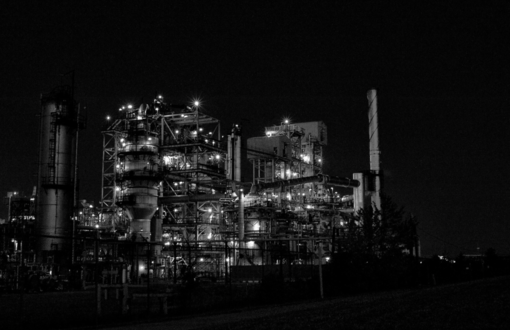
Photo by Matt Jiggins | CC BY 2.0
Five years ago, my wife and I moved to Richmond, CA and soon learned about the local emergency response protocol known as “shelter in place.”
When large fires break out in Bay Area refineries, like the century old Chevron facility near our house, first a siren sounds. Then public officials direct everyone nearby to take cover inside. Doors must be closed, windows taped shut, if possible, and air conditioning turned off.
August 6th is the fifth anniversary of such self-help efforts in Richmond. On that day in 2012, we looked up and saw an eruption worthy of Mount Vesuvius. Due to pipe corrosion and lax maintenance practices, a Chevron processing unit sprang a leak. The escaping petroleum vapor reached an ignition source. This led to a raging fire that Contra Costa County (home to four refineries) classified as a “Level 3 incident,” posing the highest level of danger.
Nineteen oil workers narrowly escaped death at the scene of the accident. It sent a towering plume of toxic smoke over much of the East Bay and fifteen thousand refinery neighbors in search of medical attention for respiratory complaints, While local property values took a hit, Chevron stayed on track to make $25 billion in profits that year.
Hunkering Down or Fighting Back?
Hunkering down at home and hoping for the best–or going to see the doctor–is no substitute for addressing a problem of this scale at its source. The Chevron fire became a wake up call for citizen action to make California refineries safer for their own workers and less harmful to air quality, community health, and the environment in general.
Since August, 2012, labor and community organizers have used lobbying, litigation, regulatory intervention, electoral politics, and strike activity to pursue these goals. There has been some safety enforcement progress, modest financial concessions by Big Oil, and related promises to behave better in the future. Yet, thanks to Big Oil’s legal and political clout in our nation’s second largest oil refining state, the wheels of environmental justice turn much too slowly.
On the plus side, after the 2012 fire, Chevron quickly pleaded “no contest” to six criminal charges filed by state and local prosecutors, agreeing to pay $2 million in fines and restitution. It was also placed on probation; while in that status, the company pledged to improve its pipe leak and emergency response training, inspection of pipes for corrosion, and overall safety conditions.
After protracted negotiations with municipal leaders in Richmond, the company began a $1 billion modernization project, which management contends will make its refinery safer and cleaner. (Skeptics fear the overhaul will lead to dirtier forms of crude oil being processed in Richmond.) City officials—elected to be stronger environmental watchdogs–secured a $90 million, post-fire community benefits agreement, which includes funding for expanded solar energy use in the city.
Suing Chevron
In 2013, Richmond also filed suit against Chevron seeking monetary damages for “years of neglect, lax oversight, and corporate indifference to necessary safety inspection and repairs.” Our current mayor, Tom Butt, predicts the case will be “settled on the courthouse steps” but the parties haven’t gotten that far yet, after four years of litigation. (Litigation against the company, filed by Ecuadoran famers for damage to their country’s rain forest is now in its fifteenth year.) Meanwhile, two other public entities in California—the counties of Marin and San Mateo—are suing Chevron, a major source of carbon emissions, over its damaging contribution to global warming.
On July 24, Chevron did finally agree to do more Richmond refinery pipe replacement, safety training, and equipment monitoring, plus pay $1 million in fines assessed by Cal-OSHA for now five-year old violations. In May, after persistent lobbying by labor and environmental groups in the Blue-Green Alliance, the Brown Administration issued what the Alliance calls “the nation’s strongest refinery safety regulations.” Echoing strike demands by the United Steel Workers during its national oil industry contract campaign three years ago, these new rules give refinery workers an expanded role in hazard reduction.
Unfortunately, our Democrat-dominated legislature has just blocked the Bay Area Air Quality Management District (and others like it around the state) from adopting stronger refinery emission curbs under consideration since the Chevron fire. This “pre-emption” of Air Quality Board authority is the price Californians will pay for legislative approval of Governor Jerry Brown’s controversial “cap and trade” program (which lets Chevron and other firms pay to pollute).
Meanwhile, in Congress, President Trump is trying to de-fund the U.S. Chemical Safety Board. This tiny $11 million a year agency probed the Richmond fire, produced an informative report on its causes, and helped shape Cal-OSHA’s resulting rule-making process. California’s new refinery safety standards reflect Chemical Safety Board recommendations that are never mandatory because the CSB lacks such legal authority. (For details, see here.)
Bi-partisan undermining or elimination of state and federal oversight bodies is a big step in the wrong direction.
At their best, Cal-OSHA, the CSB, and California’s Air Quality Districts operate at a snail’s pace, while giving corporate law-breakers an overdose of due process. In the end, they impose weaker penalties than needed or, in the CSB’s case, can’t fine anybody for anything. (That defect notwithstanding, the Trump Administration still wants to abolish the Board as part of its broader de-regulation drive.)
On the fifth anniversary of the Chevron fire in Richmond, oil industry safety investigations, limits on refinery emissions, and financial compensation for people or a planet badly scarred by Big Oil will require citizen action on a far scale larger than ever before.